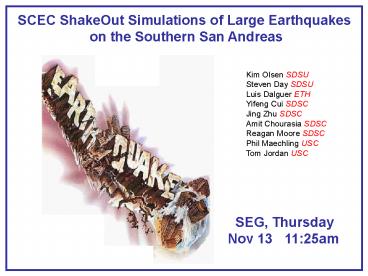Overview of the SCEC Community Modeling Environment: Cyberinfrastructure for Earthquake Science - PowerPoint PPT Presentation
1 / 32
Title:
Overview of the SCEC Community Modeling Environment: Cyberinfrastructure for Earthquake Science
Description:
Overview of the SCEC Community Modeling Environment: Cyberinfrastructure for Earthquake Science – PowerPoint PPT presentation
Number of Views:70
Avg rating:3.0/5.0
Title: Overview of the SCEC Community Modeling Environment: Cyberinfrastructure for Earthquake Science
1
SCEC ShakeOut Simulations of Large Earthquakes
on the Southern San Andreas
Kim Olsen SDSU Steven Day SDSU Luis Dalguer
ETH Yifeng Cui SDSC Jing Zhu SDSC Amit Chourasia
SDSC Reagan Moore SDSC Phil Maechling USC Tom
Jordan USC
SEG, Thursday Nov 13 1125am
2
SCEC CME Collaborations
- Intended to advance physics-based seismic hazard
analysis using HPC
NSF OCI EAR
SCEC CME Project
USGS
ISI
SDSC/PSC
IRIS
SCEC Institutions
Information Science
Source SCEC
3
Seismic Hazard Analysis
4
The FEMA 366 Report
HAZUS99 Estimates of Annual Earthquake Losses
for the United States, 2000
- U.S. annualized earthquake loss (AEL) is about
4.4 billion/yr - 74 of the total is concentrated in California
- 25 is in Los Angeles County alone
5
1994 Northridge
When 17 Jan 1994 Where San Fernando
Valley Damage 20 billion Deaths
57 Injured gt9000
6
Slip deficit on the southern SAF since last
event (1690)315 years x 16 mm/year 5.04 m
-gt Mw7.7
Major Earthquakes on the San Andreas Fault,
1690-present
14691-60 yrs 22013 yrs
1906 M 7.8
1690 M 7.7
1857 M 7.9
7
Southern California in 1857 The most
recent big one in southern California
8
Southern California in 2008
- Over 23 million people
- Fastest growing areas are close to the San
Andreas
9
HPC Aspects
10
CME Key Numerical Modeling Code
- Structured 3D 4th-order staggered-grid
velocity-stress FD developed by Olsen, enhanced
and optimized at SDSC, extensively validated for
a wide range of problems - Multi-axial perfectly matched layers absorbing
boundary conditions on the side and bottom of the
grid, zero-stress flat free surface condition at
the top - Fortran 90, MPI using domain decomposition, I/O
using MPI-IO, point-to-point and collective
communication - Staggered-grid split-node dynamic rupture
boundary condition
11
Parallelization Strategy
- Each processor responsible for performing stress
and velocity calculations for its portion of the
grid, as well as boundary conditions for each
volume - Ghost cells two-point-thick padding layer - the
most recently updated wavefield parameters
exchanged from the edge of the neighboring
sub-grid - Parallel I/O
12
Strong Scaling Performance (BGW)
13
Weak Scaling (BGW)
?h 0.4 km 0.2 km
0.13 km 0.1 km
?h 0.2 km 0.1 km
0.07 km 0.05 km
14
NSF Track2 Ranger
- 504 Tflops Sun Constellation Linux Cluster
- 3,936 16-way compute-nodes (blades)
- 123 TBs of total memory and 1.73PB of global disk
space - Largest computing system for open science
research - The first of the new NSF Track2 HPC acquisition
15
Geoscience Results ShakeOut
16
ShakeOut M7.8
- Golden Guardian
- ShakeOut M7.8
- First Earthquake drill
- based on simulation
- 5 million people
- expected to join (today,
- 10am PCT),
- Motivated changes to
- So Cal disaster plan
17
3D Velocity Model
600 km x 300 km x 80 km
San Bernardino Coachella Valley
18
Rupture Histories for Ensemble of Dynamic Sources
(ShakeOut-D)
Rupture Histories for ShakeOut-D Sources
19
Wave Propagation for Selected ShakeOut-D Source
(g3d7) 0-1Hz 14.4 Billion Grid Points
(?h100m)
Wave Propagation
20
3s-SA for ShakeOut-D (Ensemble of Source Models)
21
3-sec SA for ShakeOut-D
Mean ShakeOut-D (7 realizations)
ShakeOut-D 1-?
22
Socio-economic Effects of ShakeOut-D (using HAZUS)
23
Verification and Validation
24
Verification of ShakeOut Simulations
25
Verification of Numerical Codes
26
Comparison of 3s SAs for ShakeOut-D and ARs (Rock
Sites)
27
Simulation Storage and Dissemination
- Browser-based SCEC digital library (168 TB)
28
Science Summary
- NW-directed rupture on southern San Andreas Fault
is highly efficient in exciting L.A. Basin - Good agreement between ShakeOut simulations using
various methods - Ground motion predictions for ShakeOut-D agree
with NGA GMPEs - Ensemble of scenarios decreases uncertainty in
seismic hazards - The Nov 13 earthquake drill based on the ShakeOut
simulations, a first - ShakeOut prompted changes to disaster plan for
southern California
29
HPC Summary
- Code enhanced to deal with 32 billion mesh nodes
- Excellent speed-up to 40k cores
- Checkpoints/restart/checksum capabilities
- Input/output data transfer between SDSC disk/HPSS
to Ranger disk at 450 MB/s using Globus GridFTP - 150 TBs generated on Ranger, organized as a
separate sub-collection - Sub-collections published through SCEC digital
library (168 TB) - Ported to p650, BG/L, IA-64, XT3/4, Sun Linux,
other platforms
30
(No Transcript)
31
Comparison of 3s SAs for ShakeOut-D and ARs
(selected soil sites)
32
3-sec SA for ShakeOut-D
mean ShakeOut-D (7 realizations)
ShakeOut-D 1-?































